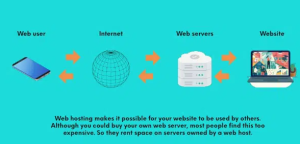Introduction
In the dynamic landscape of web hosting and cloud services, GoDaddy has emerged as a prominent player, offering a range of solutions to meet the diverse needs of website owners and businesses. One of the standout offerings from GoDaddy is its Cloud Servers – a flexible and scalable cloud computing solution. In this comprehensive guide, we’ll delve into a step-by-step exploration of GoDaddy Cloud Servers. From understanding the features to setting up and optimizing performance, this guide aims to empower bloggers, entrepreneurs, and businesses to harness the full potential of GoDaddy’s cloud infrastructure.
Step 1: Understanding GoDaddy Cloud Servers
a. Overview of GoDaddy Cloud Servers
Start by grasping the fundamentals of GoDaddy Cloud Servers. Unlike traditional hosting, cloud servers provide scalable and on-demand computing resources. GoDaddy’s offering includes features like dedicated CPU, SSD storage, and the flexibility to scale resources based on your website or application needs.
b. Key Features
Explore the key features of GoDaddy Cloud Servers. These may include multiple operating system options, root access for customization, automated backups, and robust security measures. Understanding these features lays the foundation for making informed decisions throughout the setup and management process.
c. Use Cases for Cloud Servers
Consider the various use cases for GoDaddy Cloud Servers. Whether you’re hosting a website, running applications, or managing databases, GoDaddy’s cloud infrastructure caters to a range of scenarios. Identify your specific use case to tailor the setup and configuration accordingly.
Step 2: Choosing the Right Cloud Server Plan
a. Assessing Resource Requirements
Evaluate your resource requirements. Determine factors such as the amount of CPU, RAM, and storage needed for your website or application. GoDaddy offers different plans with varying resource allocations, allowing you to choose a plan that aligns with your needs.
b. Scalability Options
Consider scalability options. One of the advantages of cloud hosting is the ability to scale resources up or down based on demand. Choose a plan that offers the flexibility to adjust resources as your website or application grows.
c. Operating System Selection
Select the appropriate operating system. GoDaddy Cloud Servers support multiple operating systems, including Linux distributions and Windows. Choose the OS that is compatible with your applications and aligns with your familiarity and preferences.
Step 3: Setting Up Your GoDaddy Cloud Server
a. Account Creation and Server Purchase
Create a GoDaddy account if you don’t have one. Once logged in, navigate to the Cloud Servers section and select a plan that suits your requirements. Complete the purchase process, including selecting additional features like SSL certificates or domain registration if needed.
b. Accessing the Control Panel
Access the GoDaddy control panel. The control panel is your central hub for managing your cloud server. Here, you can initiate server setup, configure settings, and monitor performance. Familiarize yourself with the control panel’s layout and navigation.
c. Setting Up the Server
Initiate the server setup process. Follow the guided steps provided by GoDaddy to configure your cloud server. This typically includes selecting the operating system, setting up a hostname, and defining security settings. Pay attention to any customization options offered during the setup.
Step 4: Configuring and Customizing Your Cloud Server
a. Accessing the Server via SSH or Remote Desktop
Connect to your cloud server. Depending on the operating system you chose, use SSH for Linux servers or Remote Desktop for Windows servers to establish a connection. This allows you to access the server’s command line or graphical interface for further configuration.
b. Installing Applications and Software
Install necessary applications and software. Customize your server environment by installing the tools and software required for your website or application. This may include web servers, databases, content management systems, or development frameworks.
c. Security Configurations
Prioritize security configurations. Implement best practices for securing your cloud server, such as configuring firewalls, enabling automatic updates, and setting up user permissions. GoDaddy provides security features, but additional customization enhances your server’s resilience against potential threats.
Step 5: Optimizing Performance
a. Monitoring Resource Usage
Regularly monitor resource usage. Utilize the monitoring tools provided by GoDaddy to track CPU, memory, and storage usage. Proactively identifying performance bottlenecks allows you to optimize resource allocation and maintain optimal website or application performance.
b. Scaling Resources as Needed
Scale resources based on demand. If your website experiences increased traffic or your application demands more computing power, leverage GoDaddy’s scalability options. Adjust CPU, RAM, or storage to accommodate fluctuations in resource requirements.
c. Content Delivery Network (CDN) Integration
Integrate a Content Delivery Network (CDN). Boost the speed and performance of your website by utilizing a CDN. GoDaddy often provides integrations with popular CDNs, allowing you to distribute content globally and reduce latency for users.
Step 6: Backing Up and Securing Your Data
a. Automated Backups
Enable automated backups. Protect your data by configuring automated backups through GoDaddy’s platform. Regular backups ensure that you can quickly recover your website or application in the event of data loss or system failures.
b. Data Encryption and SSL Certificates
Implement data encryption. If your website handles sensitive information, configure SSL certificates to enable secure, encrypted connections. GoDaddy offers SSL options that enhance the security of data transmitted between your server and users.
c. Regular Security Audits
Conduct regular security audits. Periodically review and update security configurations, perform vulnerability assessments, and stay informed about security best practices. Proactive security measures are essential for safeguarding your cloud server.
Step 7: Utilizing GoDaddy Support and Resources
a. Accessing Customer Support
Familiarize yourself with GoDaddy’s customer support channels. In case of issues or questions, reach out to GoDaddy’s support team through live chat, phone, or email. Utilize the extensive knowledge base and documentation available on the GoDaddy website.
b. Community Forums and Discussions
Engage with the GoDaddy community. Participate in forums and discussions to connect with other users, share experiences, and seek advice. The community can be a valuable resource for troubleshooting, tips, and insights into optimizing your cloud server.
c. Staying Informed About Updates
Stay informed about platform updates. GoDaddy regularly releases updates and improvements to its cloud hosting services. Monitor announcements and update your server as needed to benefit from the latest features and security enhancements.
Step 8: Managing Domain and DNS Settings
a. Domain Registration and Management
Manage your domain settings. If you registered your domain with GoDaddy, use the control panel to configure domain settings. This includes updating DNS records, setting up subdomains, and managing domain-related features.
b. Utilizing Domain Forwarding and Aliases
Implement domain forwarding and aliases. GoDaddy allows you to set up domain forwarding to redirect traffic to another URL. Additionally, configure domain aliases for multiple domain names to point to the same website or application.
c. DNS Security Configurations
Enhance DNS security configurations. Implement DNS security features provided by GoDaddy, such as DNSSEC (Domain Name System Security Extensions), to protect against DNS-based attacks and ensure the integrity of your domain.
Step 9: Reviewing Billing and Renewal Processes
a. Billing and Invoicing
Review billing and invoicing processes. Familiarize yourself with GoDaddy’s billing cycles, payment methods, and renewal procedures. Ensure that your payment information is up-to-date to avoid service interruptions.
b. Auto-Renewal Settings
Configure auto-renewal settings. Enable auto-renewal for your cloud server to ensure continuity of service. GoDaddy often provides options to set up automatic renewal, preventing accidental disruptions due to expired services.
c. Monitoring Resource Costs
Monitor resource costs. Keep an eye on resource usage and associated costs to optimize your cloud server’s performance and budget. Adjust resource allocations based on usage patterns and consider cost-effective alternatives if needed.
Step 10: Planning for Future Growth
a. Scalability Planning
Plan for future scalability. Anticipate the growth of your website or application and align your scalability plans with evolving needs. GoDaddy’s cloud servers offer the flexibility to scale vertically or horizontally as your requirements change.
b. Regular Performance Reviews
Conduct regular performance reviews. Periodically assess your cloud server’s performance, security, and cost-effectiveness. Identify areas for improvement, implement optimizations, and stay proactive in managing your server for optimal results.
c. Exploring Additional GoDaddy Services
Explore additional GoDaddy services. Depending on your evolving needs, consider leveraging other services offered by GoDaddy, such as managed WordPress hosting, domain privacy, or email hosting. Integrating these services can enhance your overall online presence.
Conclusion
Navigating the realm of GoDaddy Cloud Servers involves a strategic and step-by-step approach. By understanding the features, setting up and customizing your server, optimizing performance, and utilizing support resources, you can unlock the full potential of GoDaddy’s cloud infrastructure. May this comprehensive guide serve as a valuable companion on your journey to harnessing the power of GoDaddy Cloud Servers for your web hosting and computing needs.


